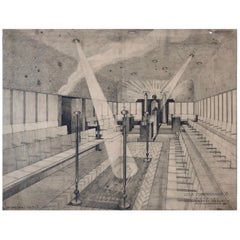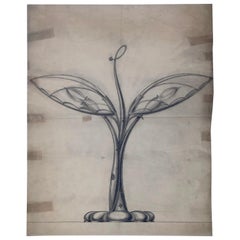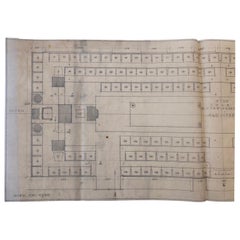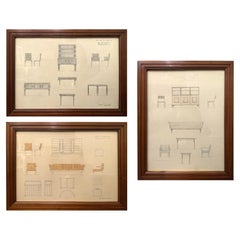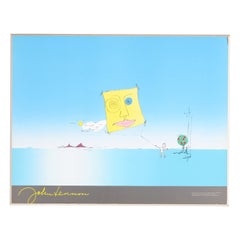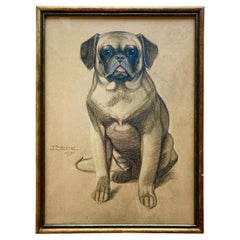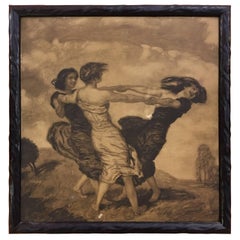Jugendstil Drawings
to
1
3
3
Height
to
Width
to
307
285
158
66
22
20
15
13
13
10
8
8
7
7
3
3
1
1
3
1
2
1
2
3
3
3
3
3
3
1
1
Style: Jugendstil
Set of Working Drawings, 1930, for a Free Masons Lodge, Schwind Gasse, Vienna
By Abarchitects
Located in Vienna, Austria
This is a rare set of 5 drawings concerning the Free Masons Lodge on the Schwind Gasse number 8, in the 4th district of Vienna.
The drawings were made in ...
Category
1930s Austrian Vintage Jugendstil Drawings
Materials
Paper
Drawing for a Table Lamp by Robert Gerlach, 1915
Located in Vienna, Austria
A rare study of a table lamp, drawn with pencil on vellum, by Robert Gerlach from circa 1915. We can assume that the materials would
be brass and glass. Whether the drawing was actu...
Category
1910s Austrian Vintage Jugendstil Drawings
Materials
Paper
$5,268 Sale Price
20% Off
Working Drawing, 140 Sitze, Free Mason Lodge, Schwind Gasse, Vienna
By AnotherView
Located in Vienna, Austria
The 5th drawing in the series, Free Mason Lodge, Schwind Gasse number 8. Listing- 4 working drawings, Free Masons, Lodge, 1930
There you will find more inf...
Category
1930s Austrian Vintage Jugendstil Drawings
Materials
Paper
Related Items
Set of Three Architectural Drawings by Carl G. Bergsten, c.1930
Located in New York, NY
Set of three architectural furniture drawings by the Sweedish arquitect Carl G. Bergsten. Circa 1930. Pencil on paper.
Dimenssions: WITH FRAME
Motto Gesundheit: W 31.5" x H 23.75" ...
Category
Mid-20th Century Swedish Jugendstil Drawings
Materials
Paper
John Lennon Drawing, "Kite, Free As A Bird", 1995
Located in Port Washington, NY
Rare Poster. John Lennon Kite Poster 22'' x 28'' Unframed in Good Condition.
Category
1990s British Jugendstil Drawings
Materials
Other
Drawing for General Electric/Jeep, possibly by Rockwell Kent
Located in Philadelphia, PA
This original drawing was created for an advertisement by General Electric for its portable power generators, here shown powering a saw wielded by two lumberjacks. Attributed to Roc...
Category
1940s American Vintage Jugendstil Drawings
Materials
Paper
$2,000 Sale Price
20% Off
H 22.25 in W 17.75 in D 1 in
Selection of 1930s Academic Study Drawings of Male Nudes
Located in Atlanta, GA
Selection of 1930's Academic Study Drawings of Male Nudes, hand drawn by Carl De Zeeuw, American, circa 1930's. The price noted below is for EACH dra...
Category
1930s American Vintage Jugendstil Drawings
Materials
Paper
Rare Pen Drawing by Giovanni Gariboldi for Paolo Buffa, Italy, 1940s
Located in Milan, IT
Rare pen drawing by Giovanni Gariboldi for Paolo Buffa.
Category
1940s Italian Vintage Jugendstil Drawings
Materials
Paper
$1,065
H 15.16 in W 14.18 in D 0.04 in
Set of 3 x 19th Century Charcoal Drawings
Located in Ongar, GB
A lovely set of 3 x antique charcoal drawings in later frames. Circa 1900.
Category
1890s European Antique Jugendstil Drawings
Materials
Parchment Paper
20th Century Signed Still Life Pencil Drawing
Located in Roma, IT
Beautiful, evocative Pencil Drawing
Still Life with Flowers and Butterfly
Early 20th century
Signed at lower right
The painting is embellished by a beautiful nineteenth-century la...
Category
1920s Italian Vintage Jugendstil Drawings
Materials
Wood, Paper
Selection of 1930s Academic Study Drawings of Male Nudes
Located in Atlanta, GA
Selection of 1930's Academic Study Drawings of Male Nudes, hand drawn by Carl De Zeeuw, American, circa 1930's. The price noted below is for EACH dra...
Category
1930s American Vintage Jugendstil Drawings
Materials
Paper
Set of Three Classical Drawings
Located in Washington, DC
Set of Three Hand Engraved Classical Sepia Drawings of Roman and Greek figures.
Category
18th Century and Earlier French Antique Jugendstil Drawings
Materials
Wood, Paper
"Seated Man, Two Positions", Drawing of Half-Nude Male Figure by Ulen, 1930s
By Paul Ulen
Located in Philadelphia, PA
Beautifully and sensitively drawn by Paul Ulen, this single sheet includes two images of a half-nude male figure, seated and reclining, wearing loose worker pants and sporting a fashionable 1930s haircut. In each case, the figure's strong, muscular body is expressed in tones of light and shadow, confidently drawn in pencil. The gridded background suggests that the figures were studies for a larger wall mural, and indeed, a major mural-esque painting by Ulen, "Bricklayer at Rest," perhaps depicting the same model, is also available from Renaissance Man Antiques...
Category
1930s American Vintage Jugendstil Drawings
Materials
Paper
$3,900
H 14.25 in W 19.25 in D 0.1 in
Set of Seven Working Drawings by José Thenée
By Jose Thenne
Located in Chicago, IL
Set of seven working drawings by José Thenée. José Thenée was a master blacksmith born in Austria in 1853 who made his home in Argentina.
Sizes:
23.25" H x 17.25" W
23" H x 14...
Category
Early 20th Century Argentine Jugendstil Drawings
Materials
Paper
Rene Prou drawing for the Paquebot France salon
By René Prou
Located in grand Lancy, CH
Rene Prou drawing for the Paquebot France salon little damage on the paper at left see photo
Category
1950s French Vintage Jugendstil Drawings
Materials
Paper
Previously Available Items
Vintage 1930s Original German Charcoal Drawing of Pug Dog by J. Steinel
Located in COLMAR, FR
An adorable, vintage dog portrait of superb quality, dated 1931. This original charcoal drawing of a pug dog is signed and dated by artist, J. Ste...
Category
1630s German Antique Jugendstil Drawings
Materials
Paper
H 16.54 in W 12.41 in D 0.6 in
Franz von Stuck Three Women
Located in Sofia, BG
Franz von Stuck black and white print signed in the right. Three women.
Munich & New York.
Category
1890s German Antique Jugendstil Drawings
Jugendstil drawings for sale on 1stDibs.
Find a broad range of unique Jugendstil drawings for sale on 1stDibs. Many of these items were first offered in the Mid-20th Century, but contemporary artisans have continued to produce works inspired by this style. If you’re looking to add vintage drawings created in this style to your space, the works available on 1stDibs include wall decorations and other home furnishings, frequently crafted with paper and other materials. If you’re shopping for used Jugendstil drawings made in a specific country, there are Austria, and Europe pieces for sale on 1stDibs. While there are many designers and brands associated with original drawings, popular names associated with this style include Abarchitects, and AnotherView. It’s true that these talented designers have at times inspired knockoffs, but our experienced specialists have partnered with only top vetted sellers to offer authentic pieces that come with a buyer protection guarantee. Prices for drawings differ depending upon multiple factors, including designer, materials, construction methods, condition and provenance. On 1stDibs, the price for these items starts at $5,930 and tops out at $16,754 while the average work can sell for $16,496.
Recently Viewed
View AllMore Ways To Browse
Silver Teapots With Burner
Snake Murano
Soldier Clock
Spanish Armada
Spanish Bull Sculpture
Spanish Vargueno
Spirit Burner Sterling
Spoon Rack Antique
Spring Glory Sterling Silver Set
Staffordshire Porcelain Spaniels
Staffordshire Tea Cups
Steel Canopy Bed
Sterling Chamberstick
Sterling Holloware
Sterling Silver Chamberstick
Sterling Silver Hip Flasks
Sterling Silver Holloware
Sterling Silver Pin Cushions
